Powder: -20°C for 3 years | In solvent: -80°C for 1 year


MS67 is a potent and selective degrader of the WD40 repeat domain protein 5 (WDR5) with a dissociation constant (Kd) of 63 nM. It exhibits no activity against protein methyltransferases, kinases, G-protein-coupled receptors (GPCRs), ion channels, and transporters. Notably, MS67 demonstrates significant anticancer properties.

| Pack Size | Availability | Price/USD | Quantity |
|---|---|---|---|
| 10 mg | 8-10 weeks | $ 954.00 |
| Description | MS67 is a potent and selective degrader of the WD40 repeat domain protein 5 (WDR5) with a dissociation constant (Kd) of 63 nM. It exhibits no activity against protein methyltransferases, kinases, G-protein-coupled receptors (GPCRs), ion channels, and transporters. Notably, MS67 demonstrates significant anticancer properties. |
| Targets&IC50 | WDR5:63 nM (Kd) |
| In vitro | MS67, at concentrations ranging from 0.001 to 1 μM, effectively induces the degradation of WDR5, with noticeable activity initiating at concentrations as low as 1 nM. This compound demonstrates a pronounced ability to deplete WDR5 across various cell lines, including six mixed lineage leukemia (MLL)-rearranged (MLL-r) acute myeloid leukemia (AML) and four pancreatic ductal adenocarcinoma (PDAC) cell lines, without exhibiting a hook effect and displaying a concentration-dependent efficacy in PDAC cells. Furthermore, MS67 reduces H3K4me2/3 levels in both MV4;11 and MIA PaCa-2 cells, while not affecting other histone methylation markers such as H3K9me3, H3K27me3, and H3K36me3. It suppresses WDR5-related gene expression and WDR5/MLL-induced H3K4 methylations on chromatin. The GI50 values for the most sensitive AML cell lines, MV4;11 and EOL-1, are 15 nM and 38 nM, respectively, highlighting its potency. The sensitivity to MS67 is distinct in MLL-r acute leukemia cell lines (MV4;11, EOL-1, MOLM13, KOPN8, RS4;11, and THP-1), in contrast to leukemia cell lines lacking MLL-r arrangements, such as K562, HL60, and a murine AML line transformed by Hoxa9 plus Meis1, which show insensitivity to MS67. Additionally, MS67 exhibits binding affinity to the VCB (VHL-Elongin C-Elongin B ternary complex) with a Kd of 140 nM. Western Blot Analysis further confirms MS67-induced WDR5 degradation in MV4;11 cells across various concentrations after 18 hours of incubation, showcasing significant activity at a DC50 of 3.7 nM. |
| In vivo | MS67, administered intraperitoneally (i.p.) at a dose of 75 mg/kg twice daily for five days a week over a period of 20 days, significantly inhibits tumor growth in vivo and extends the survival of treated mice[1]. A single i.p. injection of MS67 at 75 mg/kg yields a peak concentration (Cmax) of approximately 4.2 μM, maintaining a concentration above 0.5 μM for over 12 hours[1]. This was observed in an MV4;11 MLL-r AML xenograft mouse model, demonstrating MS67’s efficacy in inhibiting tumor growth in vivo under the specified conditions[1]. |
| Molecular Weight | 1030.14 |
| Formula | C52H59F4N9O7S |
| CAS No. | 2407452-77-9 |
Powder: -20°C for 3 years | In solvent: -80°C for 1 year
You can also refer to dose conversion for different animals. More
bottom
Please see Inhibitor Handling Instructions for more frequently ask questions. Topics include: how to prepare stock solutions, how to store products, and cautions on cell-based assays & animal experiments, etc.
MS67 2407452-77-9 MS-67 MS 67 inhibitor inhibit
